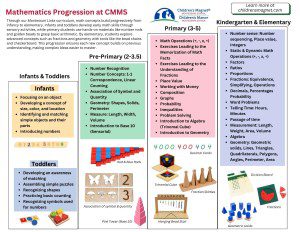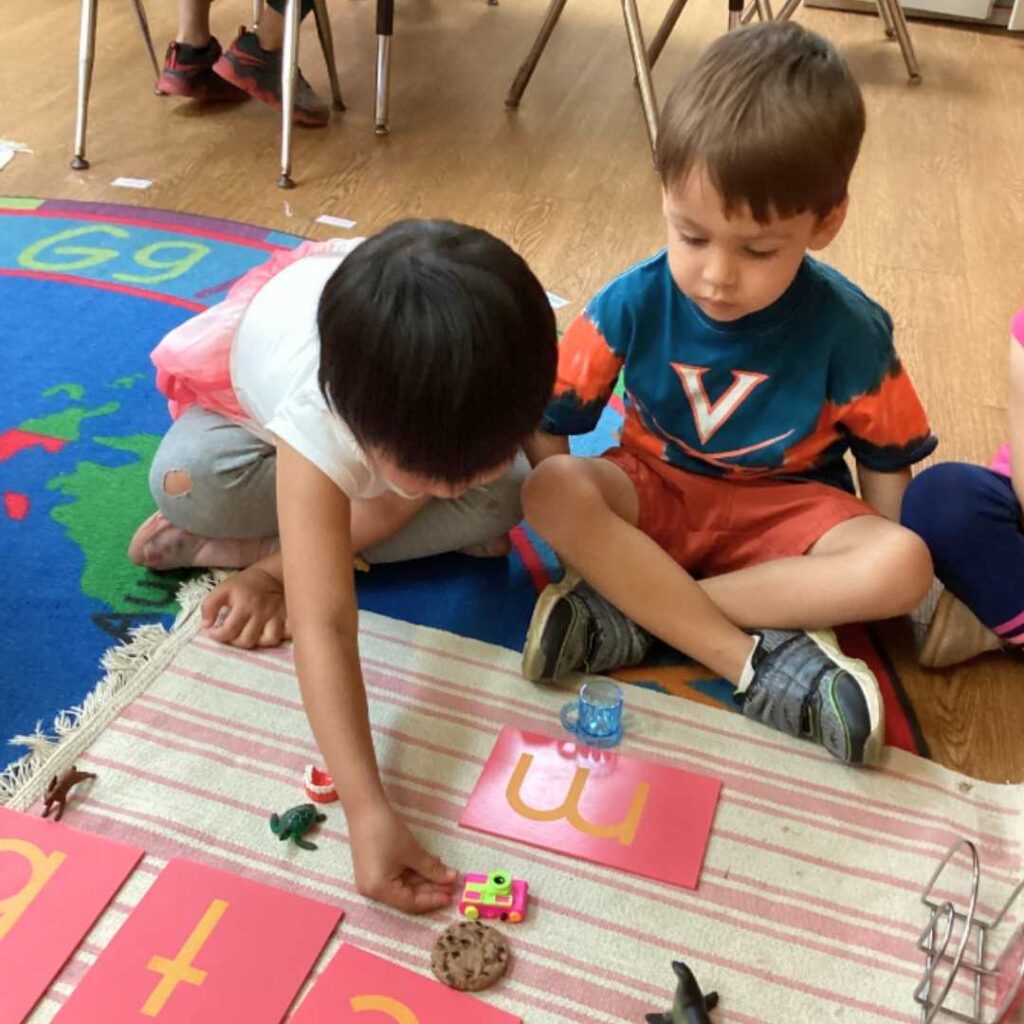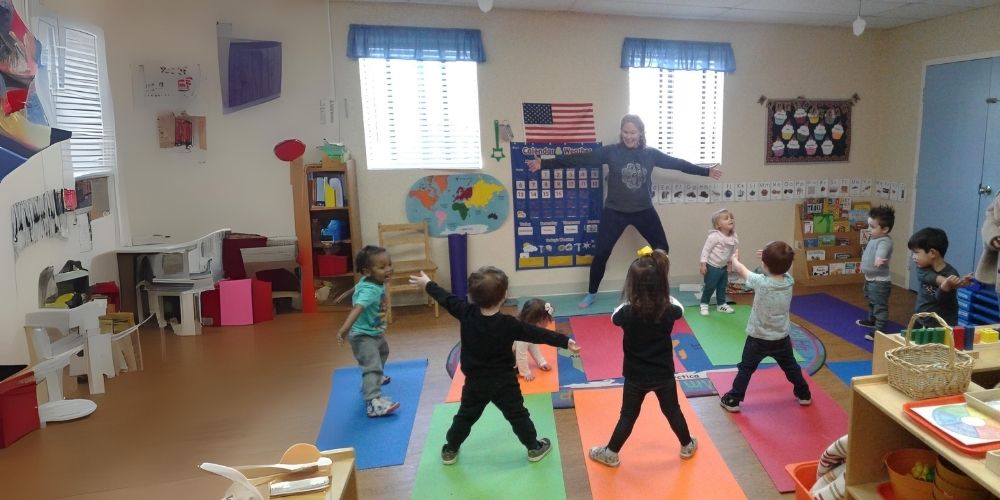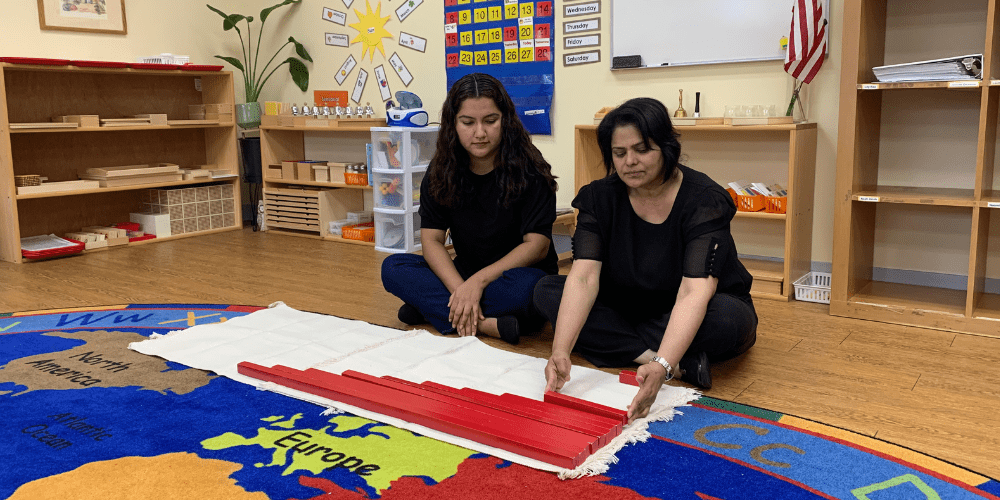The Montessori Curriculum Progression
When looking for a Montessori preschool or daycare for their child, many families may wonder: What is the Montessori method? What curriculum do you follow? What makes a Montessori school different from traditional preschools? In this post, we will answer these questions and discuss the progression of our Montessori Links Curriculum from infants to preschool and through elementary school.
Dr. Maria Montessori once said, “The goal of early education should be to activate the child’s own natural desire to learn.” This is why in a Montessori classroom we follow the child and the teacher acts as a guide, ensuring that the student meets all of their milestones and progresses through the curriculum as appropriate. One of the major benefits of the Montessori Method is that because teachers follow the individual child, if a student is ready to progress to the next level or concept, the teacher is able to accommodate that, while at the same time if a specific concept needs more work the student will have the time and support to further focus on that skill until mastery is achieved.
In the Montessori curriculum, there are 5 areas in the classroom: Practical Life, Sensorial, Cultural Studies, Mathematics, and Language. This post will focus specifically on the more concrete concepts found in the Mathematics and Language Areas, though all the Montessori areas work together to mold independent, confident, and capable learners.
Want to see the Montessori Curriculum Progression visually? Click here to download our FREE PDF!

Montessori Language Progression
In Montessori education, language skills develop progressively from infancy through elementary. Infants and toddlers engage with language through songs, stories, and conversations, building a strong foundation for communication. As they enter the primary stage, children use hands-on materials like sandpaper letters and moveable alphabets to connect sounds with symbols, laying the groundwork for future reading and writing. By elementary, students dive into advanced language concepts such as grammar, sentence analysis, and creative writing using tools like grammar symbols and sentence strips. This progression ensures each new skill builds on previous knowledge, making complex language concepts easier to master.
Infant & Toddler – Ages 0-2
The progression of language in a Montessori classroom begins with even our youngest children in the infant classroom. It is here where the basic building blocks start! Students begin by naming and identifying objects and pictures to expand their vocabulary, adding sound effects to stories, and identifying objects from their descriptions. Children also work on following simple directions, following along with various songs, using simple sign language, and even introducing numbers. As we move past the 1-year mark, children develop and expand their vocabulary; they learn basic body parts, name pictures in books, and practice basic counting. At this age, children are also developing an awareness of phonetic sounds and adding/taking away identical objects.
Pre-Primary – Ages 2-3.5
As children enter the pre-primary preschool program, they build upon previous language enrichment, vocabulary development, and speech skills, while also beginning to prepare for handwriting. This is where the unique beauty of the Montessori environment truly shines. Practical life activities, such as transferring beans with a spoon or using tongs to move pompoms, may seem simple, but they play a crucial role in developing fine motor skills and the pincer grip needed to later hold a pencil. At this stage, children also begin tracing lines and shapes as part of their handwriting preparation.

Phonemic awareness is also developing during this time — the ability to hear, identify, and manipulate the individual sounds in spoken words is an essential pre-reading skill. Using sandpaper letters, children trace the shape of each letter while simultaneously hearing and saying its sound. This multi-sensory approach reinforces the connection between the visual symbol and its corresponding sound. Throughout the day preschool students engage in activities that foster language skills such as speaking and listening, literature appreciation, and even early forms of persuasion and making requests, setting a strong foundation for their continued language development.
Primary – Ages 3-5
As children progress through the Primary Program, they continue to enhance their language skills through activities focused on language enrichment, vocabulary development, and more complex speech. They begin mastering letter-sound recognition and encoding words using the moveable alphabet. Early reading starts with visual cues, progressing to reading sight words and short sentences independently. By ages 4 or 5, students move on to advanced reading, exploring basic book series, learning long vowel sounds, and working with phonograms. They also study word functions and spelling. At this stage, preschoolers begin composition, handwriting, creative writing, and even early forms of debate and persuasion, preparing them for a smooth transition to Kindergarten!

Kindergarten & Elementary
By the Kindergarten and Elementary levels, a Montessori student’s language comprehension deepens significantly: they engage in activities such as word study, grammar, and language mechanics, honing their understanding of how language functions. In Montessori classrooms, students expand their wide range of literacy skills—from strengthening their handwriting and developing their concentration to exploring the elements of literature across major genres, including folktales, legends, myths, prose, poetry, and plays. They also delve into oral reading and language, study sayings, phrases, and idioms, and practice creative writing. This comprehensive approach nurtures their ability to express themselves clearly and confidently in both spoken and written forms.
Just as language acquisition develops through a combination of tactile and auditory learning processes, the comprehension of mathematical concepts is similarly built in a Montessori classroom with hands-on manipulatives that help a student deepen their understanding of both tangible and abstract concepts.
Montessori Math Progression
In a Montessori learning environment, math concepts build progressively from infancy to elementary. Infants and toddlers develop early math skills through sensory activities, while primary students use hands-on materials like number rods and golden beads to grasp basic arithmetic. By elementary, students explore advanced concepts such as fractions and geometry with tools like the bead chains and checkerboard. This progression ensures each new lesson builds on previous understanding, making complex ideas easier to master.
Infant & Toddler – Ages 0-2
The foundation of math in a Montessori classroom begins with our youngest learners in the infant room. Here, children start developing essential skills such as focusing on objects, understanding concepts of size, color, and spatial relationships, identifying and matching simple objects and their parts, and being introduced to numbers. As they transition into the toddler years, their mathematical awareness grows as they begin matching activities, assembling simple puzzles, recognizing shapes, and even starting to identify number symbols.

Pre-Primary – Ages 2-3.5
As students move into the Pre-Primary preschool level, they continue building on their number recognition skills and progress into more advanced number concepts such as 1:1 correspondence. This fundamental counting skill involves assigning one number to each object they are counting, ensuring they touch or point to each item only once, effectively matching each object with a single numerical value. Additionally, students work on associating symbols with quantities, connecting numerical symbols with the actual physical amounts they represent.
Even at this young age, they begin exploring geometry by learning about shapes, solids, and perimeter. They also dive into measurement concepts; including length, width, and volume. In the sensorial area of the Montessori classroom, which complements the math area, students use the Pink Tower to understand the base 10 system, enhancing their comprehension of mathematical relationships through combined tactile and visual experiences.
Primary – Ages 3-5
As the students progress to the Primary program they begin to work with Math Operations (+, -, x, ÷) and exercises leading to the memorization of math facts and fractions. Students will use number cards and golden beads to explore place value, and expand upon that with the concept of composition which deals with understanding how a larger number is made up of smaller parts. Students will also begin working with money, learning how to recognize and count coins and dollar bills. Other concepts covered include graphs, probability, and inequalities. Montessori preschoolers will also have a basic introduction to Algebra and Geometry with the use of the Montessori material the Trinomial Cube: at first glance, it looks like a simple 3D puzzle with wooden blocks of different sizes and colors. However, it represents a complex mathematical formula: (a+b+c)3(a + b + c)^3(a+b+c)3. By physically manipulating the pieces, children gain an intuitive understanding of how these elements come together to form a cube, laying the building blocks for future learning in algebra and geometry.
Kindergarten & Elementary
As students progress to the Kindergarten and Elementary levels, their mathematical understanding deepens significantly. Building on the skills built in earlier years, students enhance their number sense through activities like number sequencing, determining place value, and an introduction to integers. They begin with static operations, solving simple math problems without the need for exchanges between place values, and then advance to dynamic operations, which involve carrying and regrouping.
At this stage, students also explore more complex concepts such as factors, ratios, proportions, and fractions. They move on to working with decimals, percentages, and basic probability. Additionally, they learn to tell time using an analog clock and better understand the concept of the passage of time. Their study of measurement expands to include weight, area, and volume as they analyze various objects. In the realms of Algebra and Geometry, students are introduced to geometric solids, lines, triangles, quadrilaterals, polygons, angles, perimeter, and area, laying the groundwork for more advanced mathematical concepts in the future.
The Montessori Curriculum offers a unique and dynamic approach to early childhood education, allowing children to develop crucial language and math skills at their own pace. By following the child and using carefully designed materials, Montessori classrooms foster a deep love of learning and ensure each child masters concepts through hands-on exploration and individualized guidance. Whether through the intricacies of language development or the step-by-step progression of mathematical understanding, the Montessori Method nurtures independent, confident learners who are well-prepared for future academic success!
Interested in seeing how the Montessori approach can benefit your child? Contact us to schedule a visit or download our FREE Montessori Links Curriculum Progression PDF to learn more!
Montessori Links Curriculum Progression PDF Download
Please provide your email address to receive the PDF download!





